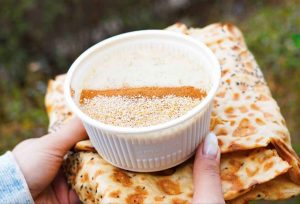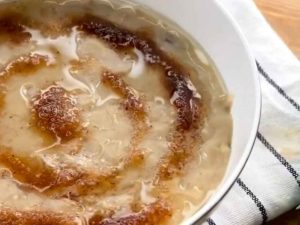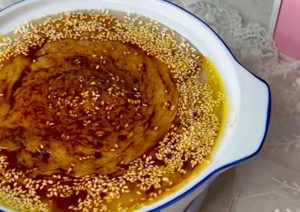Persian Halim: Traditional, Nutritious, and Global

Persian Halim is one of the oldest Iranian dishes, deeply rooted in the culture and history of the region. It is a thick, creamy, and rich dish typically made with wheat and meat. For many Iranians, Halim evokes memories of winter mornings, Ramadan, or Friday breakfasts. What makes Haleem special is not only its delicious taste and unique texture but also its cultural significance and high nutritional value.

What is Persian Halim?
Halim is mentioned in ancient Persian texts and even in Islamic manuscripts. It is a dish made by combining grains and meat, and it exists in various cultures with different names and recipes. Halim is a traditional dish made from wheat, meat (usually turkey or lamb), butter or animal fat, cinnamon, and sugar or salt. It has a soft, creamy, and slightly stretchy texture, which classifies it as a “comfort food.”
Iranian halim, such as Kale Pache and Sirabi, has a long history in Iran and is very popular among the people.

Halim in different countries:
- Iran: Typically made with wheat and lamb.
- India and Pakistan: Known as Halim or Kichra, often heavily spiced.
- Turkey: Known as Keşkek, which is very similar to Iranian Halim.
In Iran, Halim is usually prepared and served in two ways:
- Sweet Halim: Served with sugar, butter, and cinnamon.
- Savory Halim: Served with salt and animal fat.
Ingredients for 6 servings of Persian Halim
| Wheat | 2 Cups |
| Lamb | 500 G |
| Onion | 1 Medium |
| Salt | 2 Tsp |
| Water | About 10 cups |
| Butter or animal fat | 70-100 G |
| Cinnamon | 2 Tbsp |
| Sugar | 4-6 Tbsp |
| Sesame seeds or ground pistachios | 2 Tbsp |
How to Cook Persian Halim for 6 Servings
Step 1: Preparing the wheat
Place 2 cups of wheat in a large bowl. Cover completely with cold water and let it soak for at least 8-10 hours or overnight. During soaking, change the water once or twice to remove any unwanted odors and keep the wheat clean.
Step 2: Cooking the meat
Wash 500 g of lamb (neck or leg) and cut into small pieces. Peel and chop 1 medium onion, then add it to the meat in a pot. Add 2 tsp salt and about 6-7 cups of water. Cook over low heat for 2-3 hours until the meat is completely tender. After cooking, remove bones and shred the meat using your hands or a meat grinder.
Step 3: Cooking the wheat
Drain the soaked wheat and place it in a large pot with about 3 cups of water. Bring to a boil over medium heat, then reduce to low and simmer for 3-4 hours, stirring occasionally. Remove any foam on the surface and add hot water if needed to keep the wheat partially submerged. Once cooked, the wheat should be soft enough to mash easily.
Step 4: Combining meat and wheat
Add the shredded meat to the cooked wheat. From this point, continuous stirring is key to achieving the perfect texture. Use a hand or electric mixer to mix the meat and wheat until smooth and slightly stretchy. If the Haleem is too thick, add a little boiling water to thin it out.
Step 5: Adding butter or fat
Add 70-100 g of butter or animal fat to the Haleem and stir well. This step enhances the traditional aroma and gives the dish a creamy texture.
Step 6: Serving and garnishing
Serve the Halim in medium bowls. Garnish with 2 tbsp cinnamon and 4-6 tbsp sugar. For extra decoration, sprinkle 2 tbsp sesame seeds or ground pistachios. This slow and careful preparation makes Halim a patient, traditional dish often prepared in large quantities for families or special occasions.

Halim in Iranian Culture
For many Iranians, Halim is more than just food-it is a memory.
- During Ramadan, Halim is a popular choice for Suhoor or Iftar, providing long-lasting energy.
- During Muharram, it is often prepared as a charitable dish.
- On Friday mornings, long lines form outside Halim shops.
This cultural presence has made Halim more than just a meal; it is part of the social identity of Iranians.

Persian Haleem: Traditional Iranian Wheat & Meat Porridge
Ingredients
Method
- Step 1-Soak the wheat:
- Place the wheat in a large bowl, cover with cold water, and let soak overnight (8-10 hours). Change the water once or twice.
- Step 2- Cook the meat:
- In a large pot, combine lamb, onion, salt, and 6-7 cups water. Cook on low heat for 2-3 hours until the meat is tender. Remove bones and shred the meat.
- Step 3- Cook the wheat:
- Drain soaked wheat, place in a pot with 3 cups water, bring to a boil, then simmer 3-4 hours until soft. Stir occasionally and add hot water if needed.
- Step 4-Combine meat and wheat:
- Add shredded meat to cooked wheat. Mash with a hand masher or blender while stirring constantly until smooth and slightly stretchy. Adjust thickness with boiling water if needed.
- Step 5-Add butter or fat:
- Stir in butter or animal fat until fully incorporated for a creamy texture.
- Step 6-Serve and garnish:
- Serve hot in bowls. Garnish with cinnamon, sugar, sesame seeds, or pistachios.
Nutritional Benefits of Persian Halim
Halim is a complete dish combining protein, fiber, and carbohydrates.
- High protein: Thanks to the meat, it supports muscle repair.
- Fiber from wheat: Aids digestion and promotes gut health.
- Energy-boosting: The combination of complex carbs and protein keeps you full for a long time.
- Comparison with oatmeal: Like oatmeal, Halim is grain-based, but with added meat, it becomes a complete and more filling meal.
For athletes or those fasting, Halim is an excellent choice.

Serving and Garnishing Tips
Serving Halim is an important part of the experience:
- Traditionally garnished with cinnamon, sugar, and butter.
- Some add sesame seeds or ground pistachios for extra texture.
- For an American-style presentation, Halim can be served like a breakfast bowl, with toppings such as dried fruits, honey, or nuts.

Conclusion
Persian Halim is a combination of history, culture, and healthy nutrition. This dish is not only a traditional and nostalgic meal for Iranians but also an excellent choice for anyone looking for a nutritious, energy-boosting, and delicious dish.
Whether you want to try the authentic Iranian version with meat and wheat or prefer a lighter breakfast, Halim always has something to offer. If you’re looking for a meal that nourishes your body and connects you to a rich culture, Persian Halim is an exceptional choice.
1-What is Persian Halim made of?
Persian Halim is made from wheat, meat (usually lamb or turkey), butter or animal fat, and spices like cinnamon. It can be served sweet with sugar or savory with salt.
2-Is Persian Halim healthy?
Yes. Halim is rich in protein from the meat, fiber from the wheat, and complex carbohydrates that provide long-lasting energy. It is especially beneficial for athletes or those fasting during Ramadan.
3-Can I make a vegetarian version of Persian Halim?
Absolutely. You can replace meat with lentils, beans, or chickpeas for a vegetarian version. It will still be hearty, nutritious, and filling.
4- How long does it take to cook Persian Halim?
Traditional Halim takes about 5-6 hours including soaking, cooking, and stirring. For a quicker version, you can use cracked wheat or a pressure cooker to reduce the cooking time.
5-How is Halim served in Iran?
In Iran, Halim is usually served hot in bowls, garnished with butter, cinnamon, and sugar. It is a popular breakfast, especially on Friday mornings or during Ramadan.
